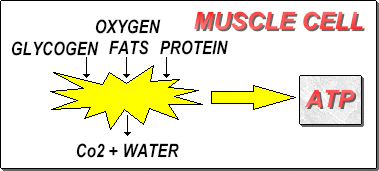
by
Tom McCullough MEd. MSS
Many coaches are confused about what type of off
season
condition program to use for football.
In the past most believed that aerobics, or long, boring jogs
were the
only way to get the job done. But is
that really true?
First, let’s take a look at the “Specificity
Principle.” In exercise science, the
Specificity Principle
refers to the mechanical similarity between a training activity and a
sport. The more similar the training
activity is to the actual sport, the greater the likelihood of a
positive
carryover to sports performance. Making
this really simple, you have to train like you compete.
Aerobic
Energy System
This type of training means that oxygen is used as our primary energy system. Aerobic training involves long term continuous activities such as walking, jogging, rowing, bicycling, etc. The activity must be more than 12 minutes of duration, and is done at 60% to 80% of the athletes’ maximum heart rate. Aerobic training will develop the cardio respiratory system well, burn body fat and develop great type I or slow-twitch fibers. (See Table 1)

Anaerobic
Energy System
Anaerobic training means that oxygen is not used
as an
energy supply for exercise. Instead, the
body uses a chemical compound called Adenosine Triphosphate (ATP), made
from
the food we eat and stored in the muscle for the energy needed to
contract
muscles.
Phosphocreatine (PC) is another energy compound
stored in
the body which when broken down, provides energy for muscle
contractions. ATP and PC work together in
the muscle in what
is known as the ATP/PC energy system.
This system provides the athlete short bursts of highly intense
energy
for short periods of time. Thus, the
limiting factor of this energy system is the supply of ATP/PC and the
body’s
ability to regenerate them. The muscle
fibers that depend on the ATP/PC system are the type II or fast-twitch. These are the same muscles developed in the
gym through weight training.
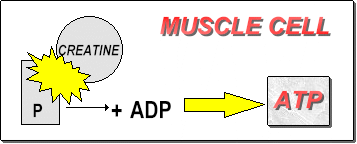
As seen on Table 1, as exercise duration increases
beyond 6
seconds, the lactic acid (anaerobic glycolysis) energy system comes
into
play. Lactic acid is a sort of waste
product
formed from carbohydrate metabolism in the body. Normally
lactic acid accumulation in the body
signals fatigue. However, if the athlete’s
body is able to carry lactic acid quickly enough through the blood,
lactic acid
can be reused for energy.
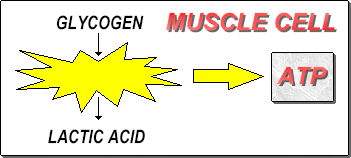
Table 1:
Energy Systems Used in Exercise
|
Alternatives
in Conditioning
As we previously discussed, athletes need to train
as
closely as possible for the sport they compete in.
Since Table 2 shows football is a sport that
involves short bursts of high intensity exercise followed by a rest
period, it
goes against the Specificity Principle to train football players using
the
aerobic energy system. Instead, coaches
need to devote time doing conditioning that develops the ATP/PC and
Lactic Acid
systems.
Table 2: Average
Total Distance and Time of Different
Positions in a Football Game
|
Offense |
Total Distance (yds) |
Total Time (min) |
Average yds/play |
Average time/play (sec) |
|
FB |
700 |
3.84 |
8.75 |
2.88 |
|
QB |
392 |
2.15 |
4.90 |
1.62 |
|
C |
336 |
3.03 |
4.20 |
2.27 |
|
G |
484 |
3.54 |
6.03 |
2.65 |
|
T |
424 |
3.61 |
5.30 |
2.70 |
|
E |
744 |
4.02 |
9.30 |
3.02 |
|
RB |
732 |
3.30 |
9.15 |
2.48 |
|
WR |
1224 |
4.03 |
15.30 |
3.0 |
|
Defense |
|
|
|
|
|
DT |
432 |
3.55 |
5.40 |
2.55 |
|
DE |
533 |
3.20 |
6.67 |
2.40 |
|
MB |
848 |
4.70 |
10.60 |
3.53 |
|
OLB |
747 |
4.95 |
9.30 |
3,71 |
|
FS |
1061 |
5.01 |
13.27 |
3.76 |
|
CB |
757 |
4.53 |
9.47 |
3.40 |
|
SS |
853 |
4.37 |
10.67 |
3.27 |
|
Special Teams |
|
|
|
|
|
KO |
200 |
|
50 |
15 |
|
Pt |
270 |
|
45 |
? |
Interval
Sprint Training (HIIT)
Current research has found that high intensity
interval
spring training does a much better job of developing the APP/PC, lactic
acid,
and even the aerobic system than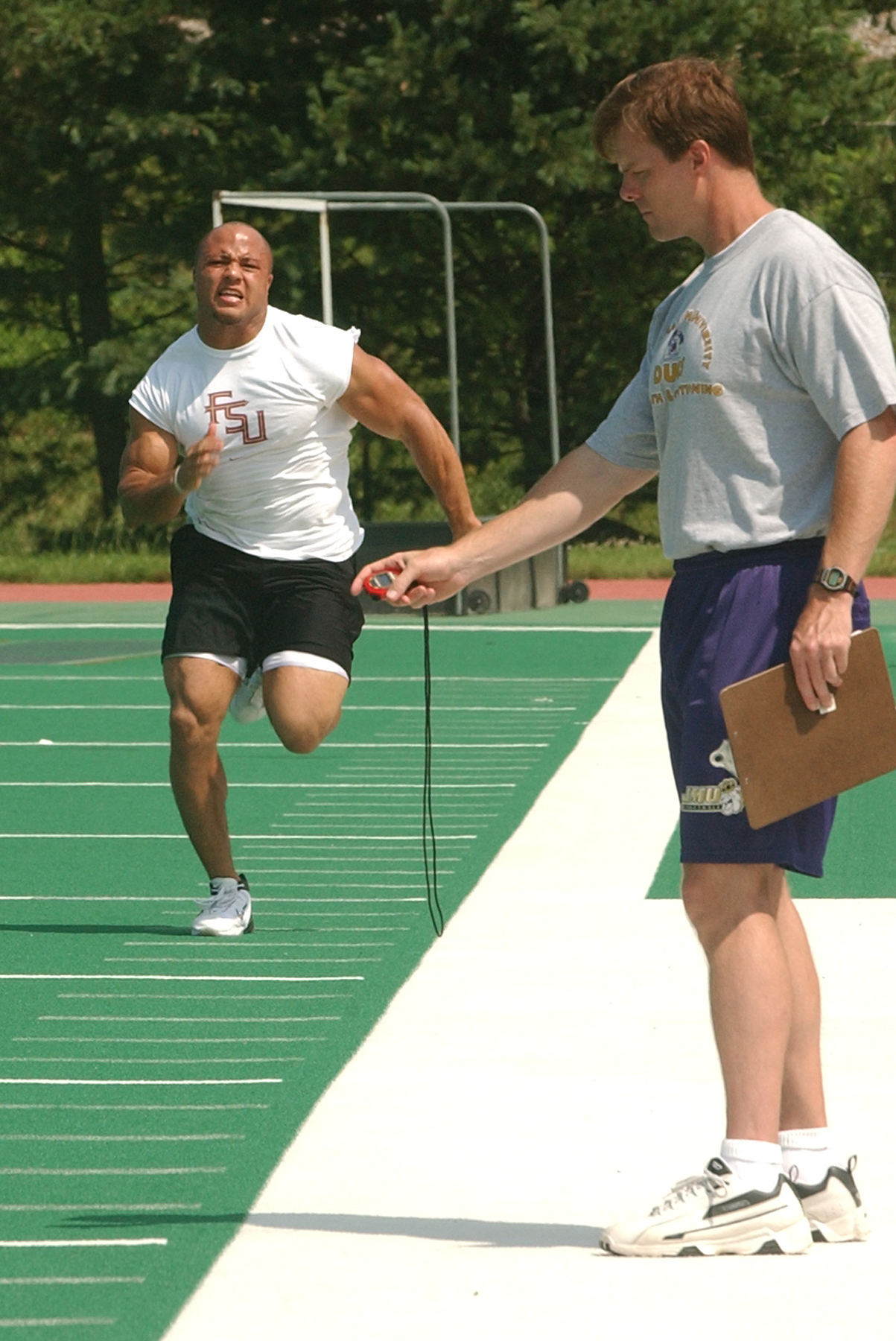 aerobic training
alone.
To make it even more enticing, interval
training can be done is in less time, and even burns more body fat per
training
period without the risk of losing hard earned muscle mass.
Interval training has also been shown to keep
the body burning fat up to 24 hours after training, unlike aerobic
training
that end shortly after you stop the exercise.
aerobic training
alone.
To make it even more enticing, interval
training can be done is in less time, and even burns more body fat per
training
period without the risk of losing hard earned muscle mass.
Interval training has also been shown to keep
the body burning fat up to 24 hours after training, unlike aerobic
training
that end shortly after you stop the exercise.
Designing
a HIIT Conditioning Program
First off, you need to determine your athletes’
anaerobic
training zone or the intensity at which the athlete must work. The anaerobic training zone is 85% to 100% of
your athletes’ maximum heart rate (MHR).
To determine MHR you need to use the following formula:
·
220 – age =
MHR
·
MHR x 85% = Anaerobic threshold
So each athlete will need to push their heart rate
up to a
minimum of 85% MHR to 100% while doing a HIIT protocol.
Bear in mind, the speed at which the athlete must
sprint will vary depending on the state of the individual athletes’
anaerobic
conditioning level.
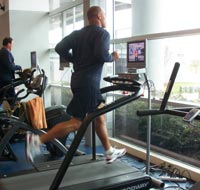 The duration of HIIT
is from
The duration of HIIT
is from
Conclusion
Of course, if you're content to do it the
old-fashioned way
and spend the better part of your valuable off-season time doing long,
boring
aerobic activities burning off much of that hard earned muscle your
athletes’ built
in the gym, then do it. However, if you
want to make more efficient use of your time, keep that muscle and get
your
athlete better prepared for the upcoming season, you might need to
consider
adding HIIT to your off-season program. If
you need any ideas or suggestions on doing this type of training please
don’t
hesitate to contact me at:
Tom McCullough.